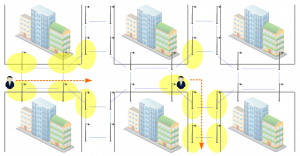An innovative smart street lighting solution with highly effective power consumption
In a modern world, the factors of environmental safety and power economy become more and more significant. Nowadays, it is important to introduce energy-efficient solutions in every-day technologies, making them more environmental-friendly and less resource-consumable. One of the most power-consuming infrastructures in a city environment is public street lighting systems, which are becoming extremely ineffective during the recent years due to the one open problem a problem of an effective light distribution among the pedestrians in a dark operation periods. It is quite noticeable fact, that the lampposts of the existing street lighting systems are always turned on during a dark time period, independently from a pedestrian traffic on the street, which means that a possibly significant amount of energy will be wasted on an empty street. Here we present a concept of a sensor network with the main application towards sensing a pedestrian’s movement and reacting at the proper way.
This concept is called the SmartLighting an innovative project in a sphere of effective power energy consumption of public street lighting systems, capable of providing up to 90% power savings during a night operation period. The system fully relies on pedestrians’ movements, calculates and provides necessary lighting zones depending on their movement direction, while the street areas without any movements remaining unlighted. This leads to a decrease of overall street lamps’ working time, saving a huge amount of energy and prolonging the lamps’ life cycle.
The SmartLighting system can be described as a wireless (based on IEEE 802.11 or 802.15.4 standard) or wired (PLC) ad-hoc multihop sensor network, installed and connected to the lampposts of the existing street lighting infrastructure. The network will have a set of necessary sensors (IR, ultrasonic sensors) in order to detect and estimate the pedestrian’s movement direction, as well as a communication interface (wired or wireless) for a timely information exchange between neighboring nodes. Each node in the network will represent an ARM-based SoC (system-on-chip) with Linux kernel and the implementations of topology auto-configuration, multi-hop routing algorithm, movement detection scheme and so on.
One of the features of the proposed project is an original implementation of the addressing scheme, based on special formatting of IPv6 header. Each node will be assigned with a unique IPv6 header, containing an information about the node’s geographical position, forwarding direction and the node’s ID. Such implementation scheme will decrease total load on the application layer, reducing the data overhead and, therefore, improving overall sensor network performance.
